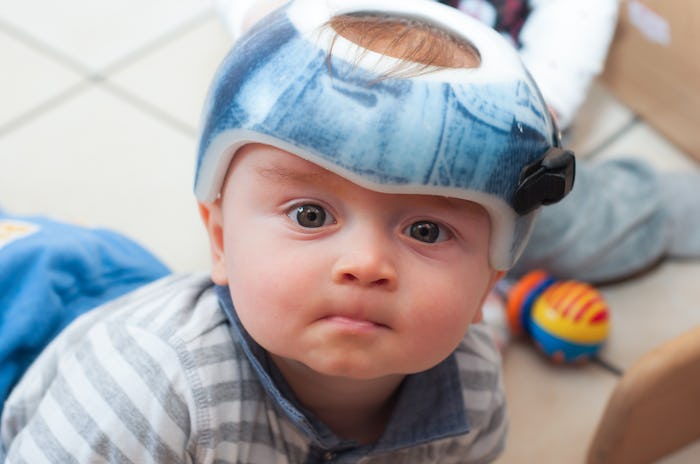Life

How To Know If Your Baby Needs A Plagiocephaly Helmet
After Chrissy Teigen's son Miles showed up on Instagram wearing a cute helmet, the condition plagiocephaly gained a lot more attention. So does your baby need a helmet, too? The signs your child might need a plagiocephaly helmet are pretty easy to spot for most parents and pediatricians.
First, it's helpful to know a little more about plagiocephaly, sometimes referred to as flat head syndrome. "Classic plagiocephaly is the result of positional molding of the skull," Dr. William Loudon, pediatric neurosurgeon at CHOC Children’s, tells Romper. "This can occur in the womb, but more commonly occurs after the child is born and is affected by the position their head lies when they sleep." When placed on their back to sleep, babies tend to doze off facing the right or left side, which can result in a flat spot on one part of the head over time, explains Dr. Loudon. In other words, plagiocephaly is simply the appearance of a flat spot on your baby's head, most commonly where they sleep.
If your pediatrician recommends using a plagiocephaly helmet for your kid, remember that it isn't a big deal, really. Chrissy Teigen described Miles' helmet as a way of "fixing his flat" in an Instagram post, and that's a cute way to think about it.
And although it may sound alarming, plagiocephaly is a pretty common condition. As many as 1 in every 12 children may be affected by plagiocephaly overall, explains Dr. Loudon. In addition, 47 percent of babies showed signs of plagiocephaly in a study of 440 infants between 7 to 12 weeks of age, according to Pediatrics.
In addition, not every kid with a plagiocephaly needs a helmet. "It’s important for parents to know that positional molding, or flat spots, are a cosmetic issue only," says Dr. Loudon. "These flat spots do not affect brain development, neuro-cognitive function, or anything else," he continues. There are also plenty of ways to reduce the risk of plagiocephaly without a helmet, such as giving your baby plenty of supervised tummy time and changing their sleep direction, as explained in Romper.
Helmets are only prescribed by doctors who think the child's head irregularities would benefit from some outside help. Your pediatrician will be on the lookout for any signs of a flat spot on your baby's head. "If you or your doctor notices any problems with the shape, the doctor will feel your child’s head and take measurements. If your pediatrician is concerned, or not comfortable managing this care, they may refer you to a pediatric neurosurgeon who will further examine your baby’s head shape with diagnostic tools and monitor their head shape development," explains Dr. Loudon. If the pediatrician or pediatric neurosurgeon feels concerned about your baby's flat spots, then they may recommend the use of a helmet. For the most part, determining whether your baby needs a plagiocephaly helmet is up to your child's pediatric team, because it's a very personalized medical device.